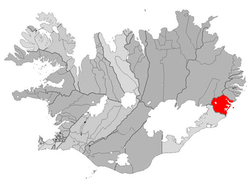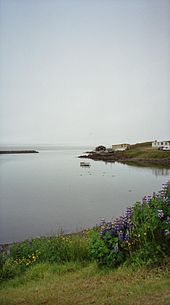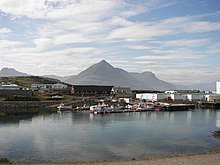Djupivogur

|
|
| Basic data | |
|---|---|
| State : |
|
| Region: | Austurland |
| Constituency : | Norðausturkjördæmi |
| Sýsla : | Suður-Múlasýsla |
| Population: | 472 (January 1, 2019) |
| Surface: | 1133 km² |
| Population density: | 0.42 inhabitants / km² |
| Post Code: | 765 |
| politics | |
| Community number | 7617 |
| Mayor: | Björn Hafþór Guðmundsson |
| Contact | |
| Website: | www.djupivogur.is |
| map | |

Coordinates: 64 ° 40 ′ N , 14 ° 17 ′ W |
|
The rural community Djúpivogur [ ˈtjuːpɪˌvɔˑɣʏr ] ( Icelandic Djúpavogshreppur , Icelandic Djúpivogur 'deep bay' ) is an Icelandic community in the Suður-Múlasýsla in the Austurland region in eastern Iceland.
On January 1, 2011, the community had 447 inhabitants.
Origin of the community
The community was formed on October 1, 1992 by the merger of the rural communities Berunes ( Beruneshreppur ), Búland ( Búlandshreppur ) and Geithellur ( Geithellnahreppur ).
On October 26, 2019, a vote on the merger with 3 other municipalities took place. The new church will be called Múlaþing .
location
The coastline is cut by three fjords, Berufjörður , Hamarsfjörður and Álftafjörður (from north to south). The main town Djúpivogur is on a peninsula between the fjords of Berufjörður and Hamarsfjörður.
Within the municipality is the Þrándarjökull glacier , one of the smallest independent glaciers.
geology
The area was strongly influenced by the central volcano Breiðdalsvulkan, which was active around 7 million years ago . It is to this that one owes the numerous peaks up to 1,100 m high around the Berufjörður.
Djúpivogur is dominated by the almost 1,000 m high Búlandstindur mountain .
Djupivogur
Characteristics
Djúpivogur is a place with 364 inhabitants on the south side of Berufjörður. The inhabitants live from fishing and tourism. The village with its colorful houses, including the old red-colored trading house Langabúð , is considered one of the most beautiful in Iceland.
history
Djúpivogur is intertwined with German history, as Hanse merchants were the first to receive commercial rights here in 1589. The Danish merchants who followed them after the introduction of the Danish trade monopoly had a large area in their area, which from Gvendarnes to Skeiðará comprised 10 municipalities from the 17th century. At the end of the 18th century, the Danish merchant JLBusch was the merchant there, from whom Ørum & Wuff took over in 1818. The oldest houses in the area, including Langabúð, date from this time .
In 1727 the area, like the Westman Islands, was affected by the so-called Tyrkjaránið when Algerian pirates attacked the country and killed or kidnapped numerous people.
Fishing has always played an important role in Djúpivogur and the surrounding area because of the favorable and protected location and proximity to the fishing grounds. It was one of the main fishing ports of East Iceland until the end of the 19th century, but then began to struggle with declines.
There is a lighthouse at angaðarsteinstanga across the harbor. Outside Djúpivogur on the cliffs there is a 2 m high stone man whose purpose is unknown. It is believed that it served as a nautical sign.
From the beginning of the 20th century there was a doctor in town.
The church was moved from Háls in Hamarsfjörður to Djúpivogur in 1894 and a pastor was resident there since 1905. The altar panel in the small wooden church that still exists today was painted in 1900 in Bergen by an Icelander living there.
Economy and Services
The place with 352 inhabitants on January 1st, 2011 is a center for economy and services in the area.
In addition to the municipal administration, there are kindergartens, a comprehensive school, medical care, sports fields and a swimming pool here.
Today, fishing and tourism, along with agriculture, are the main pillars of economic life in the area. Among other things, you will find a campsite, hotel and restaurants on site. On the other side of the fjord in Berunes, an old farm has been converted into a youth hostel in proper style. Cruise ships stop in the roadstead and disembark their passengers for day trips or trips in Djúpivogur.
Transport links
The fjord extends about 35 km into the country. The Hringvegur runs around it . The Öxi slope begins at the inner end , and although it shortens the distance to Egilsstaðir, it does not save any time because it is difficult to navigate. The discussion is currently (Jan 2008) about building and expanding the path.
The distance to Reykjavík is 554 km, to Egilsstaðir 146 km.
Papey Island
In front of the place is the island of Papey , which can be reached with small ships from Djúpivogur.
It takes its name from Irish hermit monks (papar) who are said to have lived here before the arrival of the Viking settlers in the 9th and 10th centuries (see History of Iceland ). Medieval sources refer to it. Despite numerous excavation efforts, this could not be proven archaeologically .
Art and museum
In Langabúð you will find a local history and art museum. a. occupied with the sculptor Ríkarður Jónsson (1888–1977).
About 300 to 400 m west of the harbor, along the road from Sigurður Guðmundsson (* 1942), a work of art called "Eggin í Gleðivík" (German: "The eggs in Gleðivík Bay") is installed. The replica of the eggs of 34 birds nesting in the area were placed by him there in oversize on concrete foundations in the summer of 2009.
Population development

Like most areas of Iceland now, except in the southwest around the capital Reykjavík, Djúpivogur is suffering from population loss. Between 1997 and 2005 the population decreased by 15%. Since then, the population in the municipality of Djúpivogshreppur has stagnated.
| date | Residents |
|---|---|
| Dec. 1, 1997: | 538 |
| Dec. 1, 2003: | 493 |
| Dec. 1, 2004: | 479 |
| Dec. 1, 2005: | 458 |
| Dec. 1, 2006: | 463 |
| Dec. 1, 2007: | 450 |
| Dec. 1, 2008: | 456 |
| Dec. 1, 2009: | 439 |
| Dec. 1, 2010: | 448 |
Personalities
- Hans Jonathan (* 1784 in Saint Croix , † 1827 in Djúpivogur), former slave
See also
Web links
Individual evidence
- ^ Hagstofa (Statistical Office of Iceland) (Icelandic); Accessed August 15, 2011
- ↑ Íslandshandbókin. Náttúra, saga og sérkenni. 2. bindi. Edited by T. Einarsson, H. Magnússon. Örn og Örlygur, Reykjavík 1989, 615
- ↑ a b c d e f Íslandshandbókin. Náttúra, saga og sérkenni. 2. bindi. Edited by T. Einarsson, H. Magnússon. Örn og Örlygur, Reykjavík 1989, 616
- ^ Hagstofa (Statistical Office of Iceland) (Icelandic); Accessed August 15, 2011.
- ↑ a b Vegahandbókin. Ed. Landmælingar Íslands, 2006, p. 108.
- ↑ Fréttir . ( Memento of the original from August 20, 2011 in the Internet Archive ) Info: The archive link was inserted automatically and has not yet been checked. Please check the original and archive link according to the instructions and then remove this notice. Djúpivogur municipality website, July 27, 2011, accessed August 15, 2011 (Icelandic).
- ↑ Papar . ( Memento of the original from December 30, 2015 in the Internet Archive ) Info: The archive link was inserted automatically and has not yet been checked. Please check the original and archive link according to the instructions and then remove this notice. Djúpivogur municipality website, accessed August 15, 2011 (Icelandic).
- ↑ Mats Wibe Lund: Eru til áþreifanlegar sannanir fyrir veru Papa á Íslandi fyrir landnám norrænna manna? University of Iceland website , August 5, 2010, accessed August 15, 2011 (Icelandic).
-
↑ Eggin í Gleðivík . ( Memento of the original from September 23, 2015 in the Internet Archive ) Info: The archive link was inserted automatically and has not yet been checked. Please check the original and archive link according to the instructions and then remove this notice. Djúpivogur municipality website, accessed April 8, 2018 (Icelandic). Bryndis Reynisdottir: Listaverk í Gleðivík Eftir Sigurð Guðmundsson: "Eggin í Gleðivík" . Website of the Djúpivogur municipality, March 6, 2009, accessed April 8, 2018 (Icelandic; pdf; 1.3 MB).
- ↑ Numbers from: Hagstofa (Statistical Office of Iceland) (Icelandic); Accessed August 15, 2011
- ↑ Christoph Seidler: Spectacular gene project: The miraculous story of Hans Jonathan . Spiegel Online , April 8, 2018, accessed April 8, 2018.





